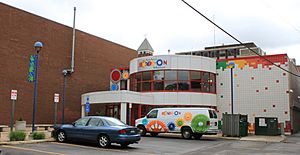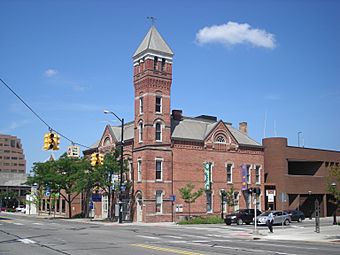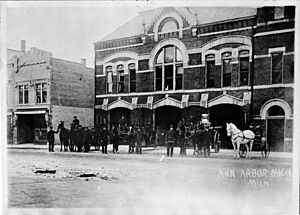Ann Arbor Hands-On Museum facts for kids

Ann Street Entrance
|
|
| Established | 1978 |
|---|---|
| Location | 220 E. Ann Street, Ann Arbor, Michigan |
|
Ann Arbor Central Fire Station
|
|

Seen from 5th Avenue
|
|
| Location | Corner of 5th Avenue and Huron Street |
| Built | 1882 |
| Architectural style | Italianate |
| NRHP reference No. | 72000658 |
| Added to NRHP | January 13, 1972 |
The Ann Arbor Hands-On Museum in Ann Arbor, Michigan, United States, is a super fun place! It's full of interactive exhibits. The museum helps kids and adults find their inner scientist. You can learn about science through trying things out, exploring, and discovering new ideas.
The museum is located in a historic building. It used to be the main Ann Arbor Central Fire Station. This fire station served the city from 1882 to 1978. The fire department later built a new station nearby. The Hands-On Museum then added a big new section to the old firehouse. This new part holds most of the museum's cool exhibits.
Contents
History of the Museum
The Hands-On Museum is in downtown Ann Arbor. It sits on a block surrounded by East Huron Street, North Fourth Avenue, East Ann Street, and North Fifth Avenue. The old firehouse is on the corner of Huron Street and Fifth Avenue.
The Historic Fire Station
Ann Arbor's firefighting story began in 1836. That's when the town started two groups of volunteer firefighters. Big fires in 1845 and 1865 made the city build water tanks, called cisterns, for fighting fires. In 1868, the town decided to pay firefighters a small amount each year.
The city decided to build a new firehouse in May 1882. It would replace a small wooden building on the same spot. City leaders, called aldermen, set aside $10,000 for the new building. Some people thought this was too much money. Ann Arbor had fewer than 10,000 people at the time. Construction on the new Italianate style firehouse began that summer. It was finished by June 1883.
Many big changes happened for the Ann Arbor fire department in the 1880s. In the same year the firehouse plans were approved, the city bought its first horses for the department. Before this, they borrowed horses from nearby draymen when needed. The first fire hydrants were put in place in 1885. This happened when the new city water system was installed. The first professional firefighters were hired in 1888.
The city switched from horses to motorized fire engines in 1915. As fire engines got bigger, it was harder to fit them in the 1882 firehouse. By the 1970s, some fire engines had to be stored outside the city. They simply wouldn't fit in the old firehouse. The city's population grew to 100,000 by 1970. That's more than ten times the number of people when the firehouse was built!
The building was added to the National Register of Historic Places in 1972. The Ann Arbor Fire Department moved to a new station on the same block in 1978.
The Museum's Journey
The Ann Arbor Hands-On Museum started in 1978. The city of Ann Arbor approved its creation. At first, it was a traveling collection of exhibits. Local experts and volunteers built these exhibits. The museum opened in its permanent home in 1982. This was in the city's historic brick firehouse. It had 25 exhibits on two floors. There was one staff person and ten volunteers.
In its first year, 25,000 people visited the museum. Kids and adults loved it! This encouraged the museum to grow faster. Four years later, the museum opened the third and fourth floors of the firehouse. The Kresge Foundation helped with a special grant. In 1993, the museum bought some nearby buildings. This led to bigger facilities and more educational programs in October 1999.
The museum received five grants from the National Science Foundation. These grants helped create new exhibits. Two popular ones were "How Things Work" and "Solve-It Central." These exhibits traveled to many science museums across the United States and Canada.
Today, the Ann Arbor Hands-On Museum has over 250 interactive exhibits. You can learn about physics, geology, math, music, and technology. Over 200,000 people visit each year! The museum is now over 40,000 square feet. It's not just for local visitors. More than 60% of its visitors come from outside the Ann Arbor area. The Detroit Free Press named it the Best Museum in 2003. The museum has also been recognized by national groups. These include the National Science Foundation and the Association of Science and Technology Centers.
Science Beyond the Museum
The museum also has an Outreach Program. It started in 2000. This program lets children explore science in different places. They can learn in classrooms, libraries, festivals, or youth centers. The program covers many science topics. These include biology, ecology, physics, chemistry, and math. All programs follow Michigan's learning goals for different grades. They also include activities to do before and after the visit.
Different Ways to Learn
- Single Visit Workshops are for classrooms from Pre-K to 8th grade.
- Series Workshops last from 3 to 12 weeks. These are for classes that want to explore science more deeply.
- Family Fun Science Nights offer interactive science and math activities. They are for the whole family. They encourage parents to get involved in their children's learning.
- The Virtual Distance Learning Program uses video calls. It lets students join interactive programs from afar. It includes materials and a Teacher's Guide for classroom experiments.
- The museum's newest program is Energy on the Road. It teaches students about renewable energy. The DTE Energy Foundation sponsors this program.
Cool Achievements and Partnerships
The Ann Arbor Hands-On Museum has won many awards and grants. It's known for its new ideas and fun learning experiences. It even received a grant from the Michigan Council for Arts and Cultural Affairs (MCACA).
The museum's influence goes beyond its visitors. In 2013, it teamed up with C.S. Mott Children's Hospital and Von Voigtlander Women's Hospital in Ann Arbor. They created the "Healing Through Hands-On Science" program. This program brings science and health activities to the museum and the hospitals. It makes hospital stays more interesting. It also provides fun activities for siblings and families of patients. This helps them not miss out on learning.
The museum also worked with the Mechanical Engineering department at the University of Michigan. They won an Editor's Award for great exhibits at the Maker Faire in 2010. This event was held at The Henry Ford in Dearborn. The students and teachers showed off the inverted pendulum. This is like the balancing system in a Segway. It showed how important balance and control are in systems. You can now find this exhibit at the museum. It has a vertical pendulum driven by a motor. Sensors help keep the pendulum standing upside down.
One cool technology exhibit at the museum is the Ferrofluid Magnetoscope. This famous interactive exhibit was made by Ann Arbor inventor Michael Flynn. It lets you control a floating liquid. This is just one of over 250 exhibits to explore!
The museum building, the old Ann Arbor Central Fire Station, was built in 1882. It was added to the National Register of Historic Places in 1972.
Explore the Exhibits!
Permanent Fun
- Concourse
This is the open lobby where you can do many fun activities. You can try whisper dishes, see a tornado, build in the "Building in a Building" area, explore the Liquid Galaxy, try the Inverted Pendulum, and play at the water table.
- All About You
This exhibit explores the human body. You can climb into a real Huron City Ambulance. You can also hear your own heartbeat and measure your Physical fitness.
- Preschool Gallery
This area is made for children aged four and younger. Kids can splash in water tables. They can also dress up like fire fighters and play on a child-sized fire engine.
- Legacy Gallery
This area shows how simple machines work. It explains how complex systems operate. You can learn how traffic lights work. You can also see the magnetism behind Teslas Egg of Columbus.
- Michigan Nature Discover Room
This exhibit gives you a pure Michigan experience. It has nature sounds and an interactive nature wall. You can see native lake fish and geology samples. Murals by Robert Zuboff and University of Michigan students decorate the room.
- World Around You
This gallery is designed to spark your imagination. It features The Bubble Capsule, magnet exhibits, and a climbing wall.
- Lyon's Country Store Exhibit
This exhibit looks like a country store from the 1930s. It's one of the few places where you can touch real, old items. These items were found in general stores almost a century ago. Inside, you can see how an old-fashioned cash register worked. You can listen to old music on a Victrola-like speaker. You can play checkers on an old checkerboard set on a barrel. You can also see old toys and games that kids played decades ago. The store honors Bob Lyons. He was a big collector of old items and helped start the museum in 1982.
- DTE Energy Foundation Light and Optics
Here, you can experience how light and optics work. Play the stringless Laser harp. Break white light into all its colors. Catch your shadow on the wall. See how refraction bends light and changes images. Observe how objects look different under light from various materials. Learn how polarizing light can change its brightness and color.
- Media Works
This exhibit helps you discover the science behind television and telecommunications.
New Adventures
- Blast Off
This exhibit lets you fill a rocket with pressurized air. Then, you launch it into the air! You can test how much pressure it takes for a rocket to reach the ceiling. Each rocket locks into place and fills with different amounts of air pressure.
- Recollections
As you dance to music, a camera senses your movements. It then turns them into colorful images on a screen.
- Block Party II
The Block Party is a creative building site. It's for young architects and engineers. You can build towers and structures using foam blocks.
- Magnetoscope
This exhibit lets you control magnetic fields. You can create amazing patterns in ferrofluid. Turn one of the cranks to raise and lower the magnets. Watch the fluid change shape and show changes in the magnetic field.


